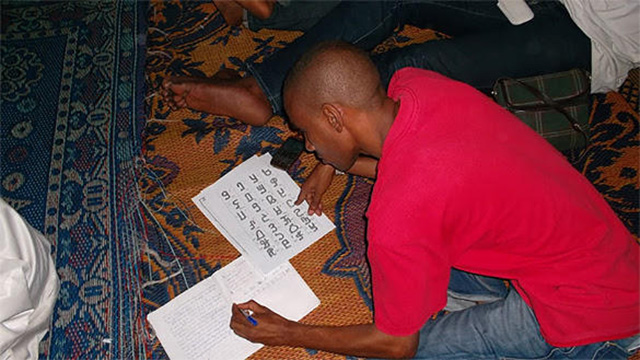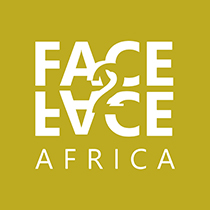Abdoulaye and Ibrahima Barry are brothers from Guinea belonging to the Fulbhe or Fulani people. Their people were originally nomadic pastoralists who later spread across West Africa and settled in countries stretching from Sudan to Senegal and along the coast of the Red Sea.
About 50 million Fulbhe people in many African countries speak Fulfulde, also known as Fulani, Fula and Pular. Until recently, they never had a script for their language and resorted to using Arabic and sometimes Latin characters to write in their native tongue.
Neither the Arabic nor the Latin alphabets could, however, accurately spell Fulani words that require producing certain sounds. Many Fulani people were compelled to improvise but this didn’t make communication effective.
Abdoulaye and Ibrahima, growing up, saw how their father made himself available to decipher letters for friends and relatives who asked for his help. Anytime he is tired or busy, Abdoulaye and Ibrahima helped, and they realized how hard it was to read those letters.
While in elementary school, one of the brothers, Abdoulaye, asked his father why their people didn’t have their own writing system. His father answered that the only alphabet they had was Arabic. Abdoulaye and his brother then decided to create an alphabet for their native language, which eventually became known as ADLaM – an acronym for a phrase that translates to “the alphabet that will prevent a people from being lost.”
In 1990, while Abdoulaye was just 10 years old and Ibrahima was 14, the two brothers, after school, would shut themselves in their room in the family’s house in Nzérékoré, Guinea, to draw on paper shapes that would make up their new alphabet.

Reports said they would take turns drawing letters, and together, assigned sounds to the shapes they came up with. Within months, they had developed an alphabet with 28 letters and 10 numerals written right to left. They later added six more letters for other African languages and borrowed words, according to Microsoft News.
The brothers started by teaching it to their younger sister before teaching people in their community, including local markets. Students were asked to teach at least three more people. The brothers further produced their own handwritten books and pamphlets and transcribed books in ADLaM.
Attending university in Guinea’s capital, Conakry, the brothers went ahead to develop ADLaM, and even started a group called Winden Jangen – Fulfulde for “writing and reading” towards that purpose.
Along the way, Abdoulaye left Guinea in 2003 and moved to Portland with his wife to study finance. Ibrahima remained in Guinea to complete a degree in civil engineering while still working on ADLaM.
Writing books, he also started a newspaper that had news stories translated from French to Fulfulde. A friend, Isshaga, photocopied these newspapers and Ibrahima distributed them to Fulbhe people, all in an effort to spread ADLaM. But not everyone was pleased with the work of the brothers. Critics argued that Fulbhe people should just learn English, French or Arabic instead of ADLaM.
In 2002, Ibrahima was arrested by military officers during a Winden Jangen meeting and was imprisoned for three months. He was never told why he was arrested and not charged with anything. “Maybe they feared that he was trying to instigate something bigger because they did not understand the script,” Abdoulaye once said.
Going to jail didn’t deter Ibrahima from continuing his work with the new writing system. In 2007, he also moved to Portland, where he studied civil engineering and mathematics while writing books.
During this period, ADLaM was spreading beyond Guinea. In Gambia, Senegal and Sierra Leone, a woman who deals in palm oil was already teaching people the writing script. In Nigeria and Ghana, a man who was pleased about ADLaM was teaching others the script.
At that point, the brothers knew that their writing system was just about to change lives and enhance literacy among millions of people around the world.
But there was a problem. In order to fully achieve their potential, the brothers had to get the alphabet onto computers. They first tried to get ADLaM encoded in Unicode, the global computing industry standard for text, but they were not successful. Saving some money, they hired a Seattle company to create a keyboard and font for ADLaM.
“Since their script wasn’t supported by Unicode, they layered it on top of the Arabic alphabet. But without the encoding, any text they typed just came through as random groupings of Arabic letters unless the recipients had the font installed on their computers,” Microsoft News wrote in 2019.
Its report said Ibrahima then decided to refine the letters the Seattle font designer developed by enroling in a calligraphy class at Portland Community College.
The instructor, who was moved by Ibrahima’s story, helped him get a scholarship to a calligraphy conference at Reed College in Portland, where he met Randall Hasson, a calligraphy artist and painter who has also done extensive research on ancient alphabets.
With Hasson’s help, ADLaM became one of the talks at a calligraphy conference in Colorado a year after the two had met. At that conference, Ibrahima got introduced to Michael Everson, one of the editors of the Unicode Standard.
With his help, the brothers put together a proposal for ADLaM to be added to Unicode. In 2014, the Unicode Technical Committee approved ADLaM and the alphabet was included in Unicode 9.0 and was released in June 2016.
But there was another challenge. The brothers understood that for ADLaM to become usable on computers, it had to be supported on desktop and mobile operating systems. The script also needed to be incorporated on social networking sites in order to increase its reach and make it more accessible.
Andrew Glass, a part of the Unicode Technical Committee and a senior program manager at Microsoft, helped the brothers get the needed support at Microsoft. Eventually, Microsoft developed an ADLaM component for Windows and Office within Microsoft’s Ebrima font, which also supports other African writing systems.

ADLaM support also got included in the Windows 10 May 2019 update to allow users to type and see ADLaM in Windows, including in Word and other Office apps.
Microsoft’s support “is going to be a huge jump for us,” Abdoulaye, who is now 39, said last year in Portland. At the moment, hundreds of thousands of people around the world have learned ADLaM, and there are ADLaM learning centers in Africa, Europe and the U.S.
Many Fulbhe people, who had never learned to read and write in English or French, are now able to connect around the world and have a sense of cultural pride, said Abdoulaye “Bobody” Barry (not ADLaM’s creator Abdoulaye), who has also learned and taught ADLaM.
“This is part of our blood. It came from our culture,” he said. “This is not from the French people or the Arabic people. This is ours. This is our culture. That’s why people get so excited.”
There are now scores of ADLaM pages on Facebook, and people, including children, are learning the script together on messaging apps.
Suwadu Jallow, who emigrated to the U.S. from Gambia, and has learned the script said: “Having this writing system, you can teach kids how to speak (Fulfulde) just like you teach them to speak English. It will help preserve the language and let people be creative and innovative.”




